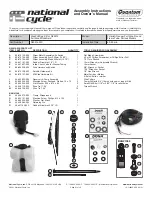
ROYAL ENFIELD WORKSHOP MANUAL
stems and rockers, with the rocker box covers
removed. To remove the rocker box covers the
petrol tank must be taken off. (See subsection 5.)
The correct clearance is nil or as little as
possible with the engine COLD.
To make the adjustment hold the push rod
bottom end (top hexagon) and turn the locknut
(middle hexagon) to the left. Screw the push rod
cup (bottom hexagon) to the left to take up
clearance or to the right to increase the clearance,
at the same time holding the push rod bottom end
(top hexagon). Lock the adjustment by tightening
the locknut against the push rod end and then
re-check the clearance.
Owing to the initial bedding down of the
wearing surfaces, the tappets on new engines
may require adjustment after the first few
hundred miles.
4. Ignition Timing
The setting of the ignition timing depends
upon the position of the magdyno pinion relative
to the magdyno shaft.
To obtain access to the magdyno pinion it is
necessary to remove the timing cover (see
Subsection 1).
The pinion is mounted on a smooth taper on
the magdyno shaft and held in position by a nut
(Right Hand Thread). To remove the pinion undo
the nut and use the special extractor tool supplied
with the tool kit.
Before setting the timing, adjust the contact
breaker points to a clearance of .012 - .015 in.
when fully opened and put the ignition lever in
the full advance position. See that the stop screw
in the magneto cam plate is in the end of the slot
and that the plate is not sticking.
To set the timing, turn the engine until the
piston is 7/16 in. – 1/2 in. for the 350cc. Engine,
or 5/16 in. for the 500cc. Engine, before top dead
centre on the compression stroke, i.e., with both
valves closed.
Insert a piece of thin tissue paper between the
points of the contact breaker and turn the
magneto forwards or clockwise, looking on the
contact breaker, until the paper can just be pulled
out. Give the pinion a sharp tap to secure it on
the shaft and then lock it by tightening the nut.
5. Removal of the Petrol Tank
Turn off the
petrol tap.
Disconnect the petrol pipe.
Remove the two bolts which secure the tank
to the frame at the front and rear and it can then
be lifted clear.
6. Removal of the Cylinder Head
Remove the petrol tank (see Subsection 5).
Disconnect the engine steady.
Disconnect the plug lead and oil pipe.
Remove the exhaust pipe.
Push the carburetter back clear of the studs
after removing the fixing nuts.
Remove the rocker-box covers.
Remove the decompressor cable from the
lever on the handlebar.
Turn the engine until both valves are closed.
Remove the rockers and bearings complete
by undoing four 1/4 in. nuts on each.
Lift out the push rods.
Remove six nuts, taking care not to lose the
washers.
Remove the 1/4 in. nut above the tappet chest
to avoid possible damage to the crankcase.
Lift the cylinder head off the barrel, tapping
it gently beneath the exhaust and inlet ports with
a hide hammer to break the carbon seal. Do not
tap the fins.
When fitting the head again, apply jointing
compound to both sides of the gasket, replace
the six nuts and tighten them progressively and
diagonally from one side to the other to prevent
distortion.
Replace the 1/4 in. nut above the timing
chest.
Replace the push rods with the adjustable
parts downwards, remembering that the shorter
rod is the inlet.
Replace the rockers and bearings, making
sure that the oil feed holes are at the bottom and
that the caps and bases are in line when tightened
down. A sharp tap with a hammer on the end of
the rocker will help to ensure this. See that the
valve stem caps are in place.
After the engine has been run long enough to
get thoroughly hot, the tightness of the nuts
should be re-checked.
It will be found convenient for this purpose to
use a small auxiliary petrol tank while the engine
Section C2 Page 2
www.hitchcocksmotorcycles.com
Summary of Contents for 350 BULLET 1949
Page 7: ...ROYAL ENFIELD WORKSHOP MANUAL w w w h i t c h c o c k s m o t o r c y c l e s c o m ...
Page 53: ...ROYAL ENFIELD WORKSHOP MANUAL w w w h i t c h c o c k s m o t o r c y c l e s c o m ...
Page 59: ...ROYAL ENFIELD WORKSHOP MANUAL w w w h i t c h c o c k s m o t o r c y c l e s c o m ...
Page 71: ...ROYAL ENFIELD WORKSHOP MANUAL w w w h i t c h c o c k s m o t o r c y c l e s c o m ...
Page 81: ...ROYAL ENFIELD WORKSHOP MANUAL w w w h i t c h c o c k s m o t o r c y c l e s c o m ...
Page 100: ...ROYAL ENFIELD WORKSHOP MANUAL NOTES w w w h i t c h c o c k s m o t o r c y c l e s c o m ...
Page 101: ...ROYAL ENFIELD WORKSHOP MANUAL NOTES w w w h i t c h c o c k s m o t o r c y c l e s c o m ...
















































